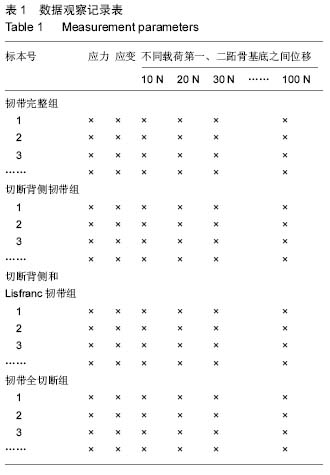| [1] Salvi AE.Lisfranc injuries: a matter of ligament disruption.J Foot Ankle Surg. 2014;53(5):674-676.
[2] Benirschke SK, Meinberg E, Anderson SA,et al.Fractures and dislocations of the midfoot: Lisfranc and Chopart injuries.J Bone Joint Surg Am. 2012; 94(14):1325-1337.
[3] Welck MJ, Zinchenko R, Rudge B.Lisfranc injuries. Injury. 2015;46(4):536-541.
[4] Zhang H, Min L, Wang G, et al.Clinical and radiographic evaluation of open reduction and internal fixation with headless compression screws in treatment of lisfranc joint injuries.Zhongguo Xiu Fu Chong Jian Wai Ke Za Zhi. 2013; 27(10):1196-1201.
[5] Eleftheriou KI, Rosenfeld PF.Lisfranc injury in the athlete: evidence supporting management from sprain to fracture dislocation.Foot Ankle Clin. 2013;18(2): 219-236.
[6] Granata JD, Philbin TM.The midfoot sprain: a review of Lisfranc ligament injuries.Phys Sportsmed. 2010; 38(4): 119-126.
[7] Boffeli TJ,Pfannenstein RR,Thompson JC.Combined medial column primary arthrodesis, middle column open reduction internal fixation, and lateral column pinning for treatment of Lisfranc fracture-dislocation injuries.J Foot Ankle Surg.2014; 53(50):657-663.
[8] Ly TV, Coetzee JC.Treatment of primarily ligamentous Lisfranc joint injuries: primary arthrodesis compared with open reduction and internal fixation. A prospective, randomized study.J Bone Joint Surg Am. 2006;88(3): 514-520.
[9] Watson TS, Shurnas PS, Denker J.Treatment of Lisfranc joint injury: current concepts.J Am Acad Orthop Surg. 2010c; 18(12):718-728.
[10] Nery C, Réssio C, Alloza JF.Subtle Lisfranc joint ligament lesions: surgical neoligamentplasty technique.Foot Ankle Clin. 2012;17(3):407-416.
[11] Nunley JA, Vertullo CJ.Classification, investigation, and management of midfoot sprains: Lisfranc injuries in the athlete.Am J Sports Med. 2002;30(6):871-878.
[12] Lorenz DS, Beauchamp C.Functional progression and return to sport criteria for a high school football player following surgery for a lisfranc injury.Int J Sports Phys Ther. 2013; 8(2):162-171.
[13] Rettedal DD, Graves NC, Marshall JJ, et al. Reliability of ultrasound imaging in the assessment of the dorsal Lisfranc ligament. J Foot Ankle Res. 2013;6(1):2-7.
[14] de Palma L, Santucci A, Sabetta SP, et al. Anatomy of the Lisfranc joint complex.Foot Ankle Int. 1997;18(6): 356-364.
[15] 郭洪亮,伊力哈木•托合提,李山珠,等.以解剖学定位Lisfranc韧带损伤的植入物内固定修复[J].中国组织工程研究,2015,19(11):1732-1738.
[16] Kura H, Luo ZP, Kitaoka HB, et al. Mechanical behavior of the Lisfranc and dorsal cuneometatarsal ligaments: in vitro biomechanical study. J Orthop Trauma. 2001;15(2):107-110.
[17] 闫荣亮,曲家富,彭义,等.Lisfranc韧带解剖与拉伸生物力学研究[J].中华创伤骨科杂志,2013,15(3):230-234.
[18] 张学斌.Lisfranc韧带对前足稳定性的研究[D]. 石家庄:河北医科大学.2008.
[19] 马昕,顾湘杰,黄煌渊,等.足横弓三维形态的生物力学意义[J].中华骨科杂志,1998,18(9):528-531.
[20] 洪劲松,潘永雄,李中万.早期手术治疗跖跗关节损伤[J].现代医院,2009,9(5):45-46.
[21] 潘永雄,杨仲,付小勇. 陈旧性Lisfranc骨折脱位的治疗[J].中华创伤骨科杂志,2010,12(7):697-699.
[22] Richter M, Wippermann B, Krettek C,et al.Fractures and fracture dislocations of the midfoot: occurrence, causes and long-term results.Foot Ankle Int. 2001; 22(5):392-398.
[23] Demirkale I, Tecimel O, Celik I,et al.The effect of the Tscherne injury pattern on the outcome of operatively treated Lisfranc fracture dislocations.Foot Ankle Surg. 2013; 19(3):188-193.
[24] Solan MC, Moorman CT 3rd, Miyamoto RG,et al.Ligamentous restraints of the second tarsometatarsal joint: a biomechanical evaluation.Foot Ankle Int. 2001;22(8):637-641.
[25] Kura H, Luo ZP, Kitaoka HB, et al.Mechanical behavior of the Lisfranc and dorsal cuneometatarsal ligaments: in vitro biomechanical study.J Orthop Trauma. 2001; 15(2):107-110.
[26] 田竞,周大鹏,于海龙,等.双Endobutton治疗单纯Lisfranc韧带损伤[J].中华创伤骨科杂志,2012,14(9):752-754.
[27] 文艺,冯品,张晖,等.同种异体肌腱与螺钉固定修复Lisfranc关节韧带损伤的生物力学比较研究[J].四川大学学报(医学版),2013, 44(2):222-225.
[28] Panchbhavi VK, Vallurupalli S, Yang J, et al.Screw fixation compared with suture-button fixation of isolated Lisfranc ligament injuries.J Bone Joint Surg Am. 2009;91(5):1143-1148.
[29] Ahmed S, Bolt B, McBryde A.Comparison of standard screw fixation versus suture button fixation in Lisfranc ligament injuries.Foot Ankle Int. 2010; 31(10):892-896.
[30] Schepers T.Acute distal tibiofibular syndesmosis injury: a systematic review of suture-button versus syndesmotic screw repair.Int Orthop. 2012; 36(6): 1199-1206. |
.jpg)


.jpg)
.jpg)
.jpg)
.jpg)